AMD Ryzen 7 8700G and Ryzen 5 8600G Review: Zen 4 APUs with RDNA3 Graphics
by Gavin Bonshor on January 29, 2024 9:00 AM EST- Posted in
- CPUs
- AMD
- APUs
- Phoenix
- 4nm
- Zen 4
- RDNA3
- AM5
- Ryzen 8000G
- Ryzen 7 8700G
- Ryzen 5 8600G
CPU Benchmark Performance: Power, Productivity and Web
Our previous sets of ‘office’ benchmarks have often been a mix of science and synthetics, so this time, we wanted to keep our office and productivity section purely based on real-world performance. We've also incorporated our power testing into this section.
The biggest update to our Office-focused tests for 2024 and beyond includes UL's Procyon software, which is the successor to PCMark. Procyon benchmarks office performance using Microsoft Office applications and Adobe Premier Pro's video editing capabilities.
We are using DDR5-5200 memory as per the JEDEC specifications on the Ryzen 7 8700G and Ryzen 5 8600G, as well as DDR4-3200 on the Ryzen 7 5700G and Ryzen 5 5600G. The same methodology is also used for the AMD Ryzen 7000 series and Intel's 14th, 13th, and 12th Gen processors. Below are the settings we have used for each platform:
- DDR5-5200 CL44 - Ryzen 8000G
- DDR4-3200 CL22 - Ryzen 5000G
- DDR5-5600B CL46 - Intel 14th & 13th Gen
- DDR5-5200 CL44 - Ryzen 7000
- DDR5-4800 (B) CL40 - Intel 12th Gen
Power
The nature of reporting processor power consumption has become, in part, a bit of a nightmare. Historically the peak power consumption of a processor, as purchased, is given by its Thermal Design Power (TDP, or PL1). For many markets, such as embedded processors, that value of TDP still signifies the peak power consumption. For the processors we test at AnandTech, either desktop, notebook, or enterprise, this is not always the case.
Modern high-performance processors implement a feature called Turbo. This allows, usually for a limited time, a processor to go beyond its rated frequency. Exactly how far the processor goes depends on a few factors, such as the Turbo Power Limit (PL2), whether the peak frequency is hard coded, the thermals, and the power delivery. Turbo can sometimes be very aggressive, allowing power values 2.5x above the rated TDP.
AMD and Intel have different definitions for TDP that are, broadly speaking, applied the same. The difference comes from turbo modes, turbo limits, turbo budgets, and how the processors manage that power balance. These topics are 10000-12000 word articles in their own right, and we’ve got a few articles worth reading on the topic.
- Why Intel Processors Draw More Power Than Expected: TDP and Turbo Explained
- Talking TDP, Turbo and Overclocking: An Interview with Intel Fellow Guy Therien
- Reaching for Turbo: Aligning Perception with AMD’s Frequency Metrics
- Intel’s TDP Shenanigans Hurts Everyone
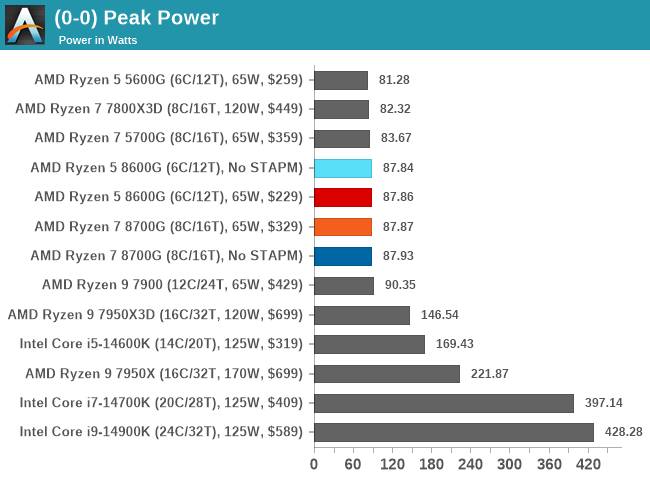
Using a broad range of processors from top to bottom in our analysis, we can see that both the Ryzen 7 8700G and Ryzen 5 8600G APUs pull just under 88 W at full load, which is around 35 W extra than the rated 65 W TDP. This is normal given that AMD and the AM5 platform use another power metric called Package Power Tracking (PPT), which allows more power to the CPU socket. Comparing the Ryzen 8000G series to the Ryzen 5000G series, the Zen 4 models pull around 6% more power at peak loads.
Looking a little deeper into the power of the Ryzen 7 8700G, we've used both the CineBench R23 Multi-Threaded test and the game F1 2022 at 1080p high settings to gauge their different power requirements. Typically, with a heavier CPU load, such as those employed when rendering, we can see CineBench R23 Mt; we consistently drew around 87 to 88 W of power, which is consistent with our peak values.
Using F1 2022 to see how power varies between a rendering workload, depending on how intensive the scene was, we observed between 65 W and 82 W, including the Zen 4 cores and the Radeon RNDA3 graphics processor balancing performance between the two entities. As mentioned, this is above the rated 65 W TDP AMD has given this chip, but as we've found over the years, this isn't an exact science, and TDP figures are to be taken with a pinch of salt, especially on desktop platforms.
With power values at full load between 65 W and 88 W, this means that they are easier to cool, with both the Ryzen 7 8700G and Ryzen 5 8600G both coming with supplied AMD Wraith stock CPU coolers.
Update 02/01/24: We have investigated reports of Skin Temperature-Aware Power Management (STAPM) issues on the Ryzen 8000G APUs; our findings are below.
With F1 2023 as the game of choice and using the AMD Ryzen 7 8700G APU, we sought to investigate issues relating to STAPM limitations. As shown in the above graph, after 3 minutes of sustained gaming, the overall CPU package power dropped by around 22% from a sustained load of between 83-84 W down to around 65 W. Unfortunately, AMD has left STAPM limitations placed on their mobile chips in place for their ported to desktop Ryzen 8000G series, which poses as limiting power has a negative impact on performance, especially where an APU with integrated graphics is concerned. First reported by Gamers Nexus, AMD did respond to them directly about the issue, which is as follows:
"We found out that STAPM is being incorrectly applied to the desktop parts. It shouldn't be applied to the desktop parts. A future BIOS update should correct this behavior. If nothing else, you caught something that is going to help a lot of [customers], so better to catch it sooner than later."
Update 02/23/24: We have retested the prolonged power performance with the latest firmware, and our results are below.
Using the same game (F1 2023) at the same settings (720p High) with the latest firmware that removes STAPM, we can see that there is no power throttling, which we initially saw from our initial testing. We can see that power is sustained for over 10 minutes of testing, and we saw no drops in package power when gaming for a prolonged period of time. We did test this for much longer, but it would have made the chart unreadable, so we opted to show how power remained the same for 10 minutes. The latest firmware on whatever AM5 motherboard is being used, power, and, ultimately, performance remains consistent with what the Ryzen 7 8700G should have been getting at launch. This is also the same for other Ryzen 8000G APUs, as STAPM has now been completely removed from the firmware by AMD.
Productivity and Web
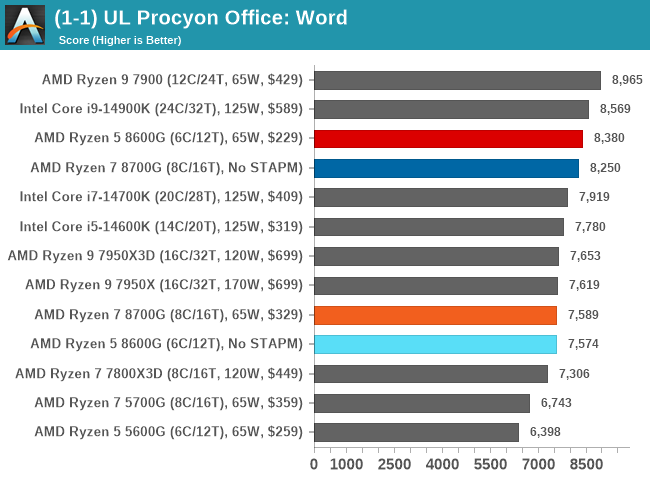
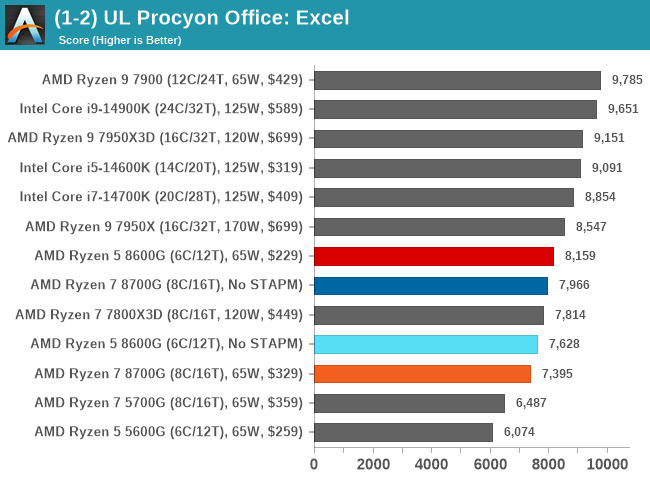
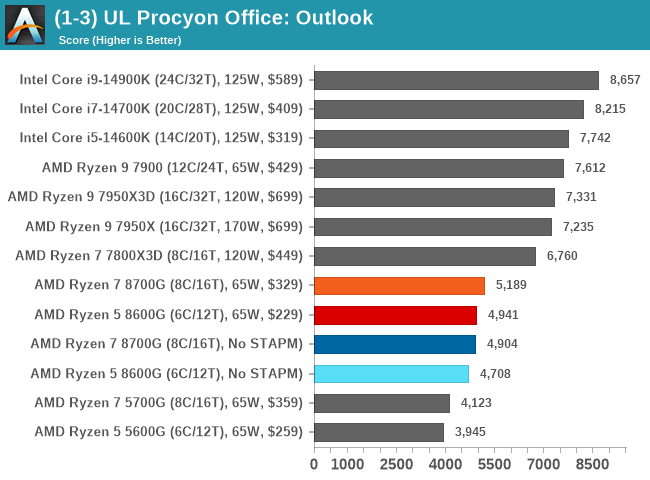
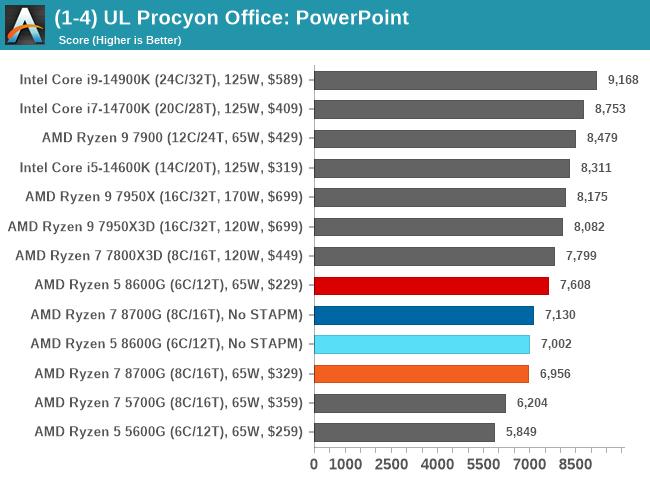
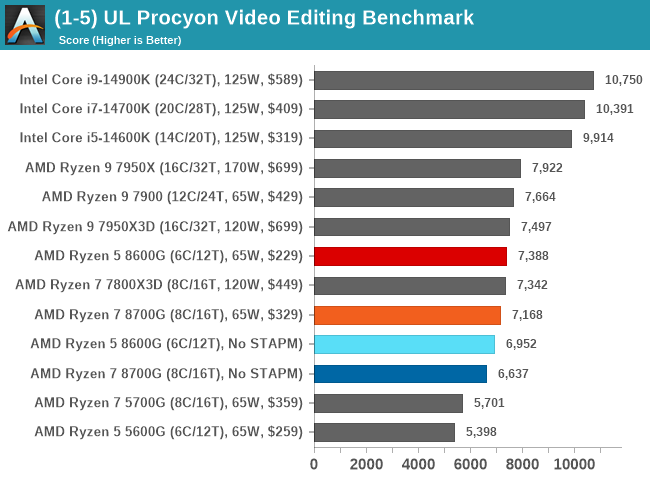
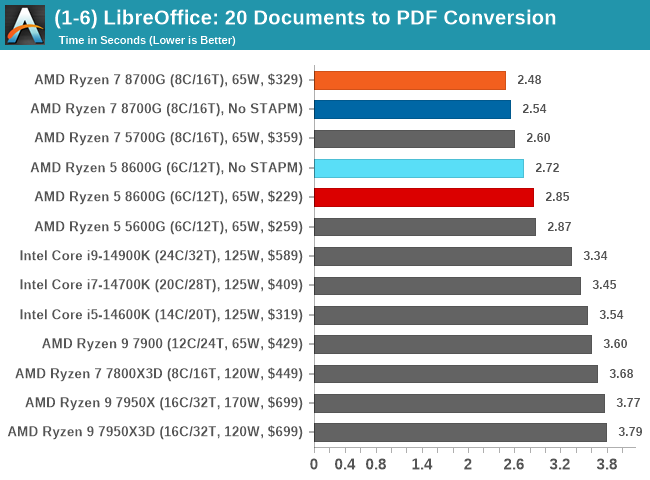
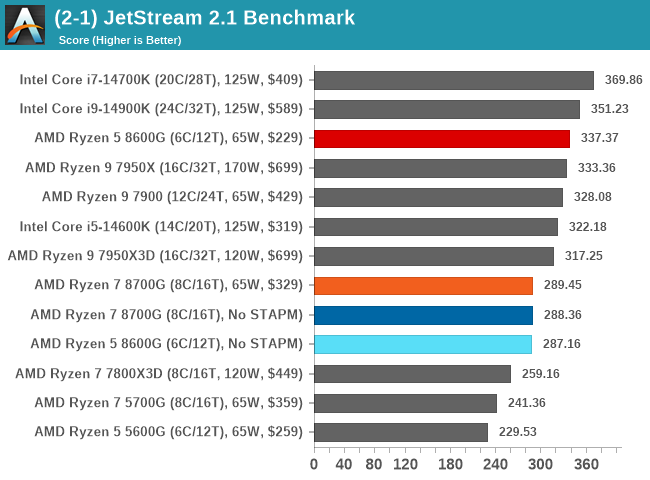
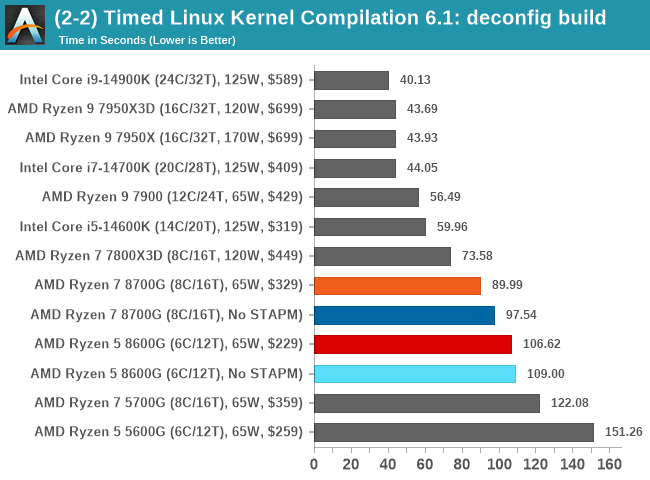
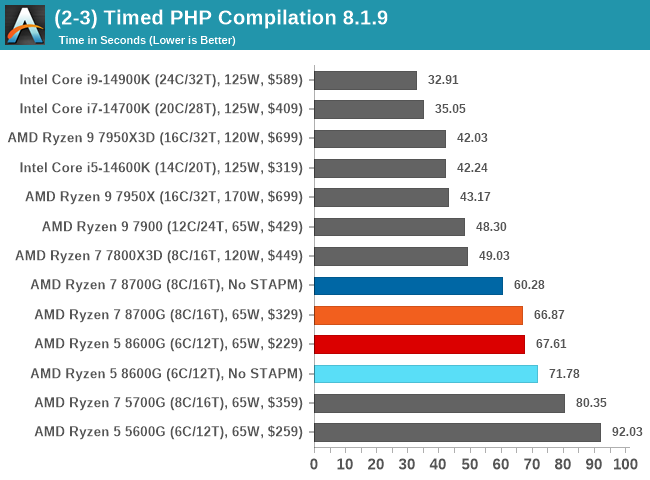
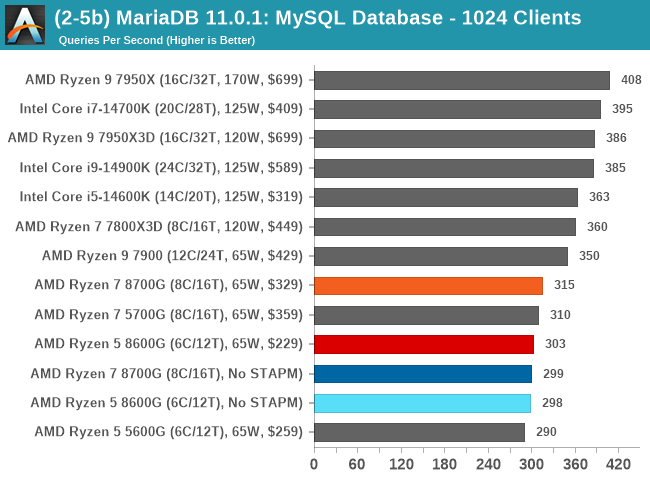
Across our web and productivity section of the suite, we saw performance where we expected to see it, typically above the Ryzen 5000G but below that of the 'proper' Zen 4 desktop chips. We did see strong performance in LibreOffice, which APUs typically do well in.
Re-benchmarking the Ryzen 7 8700G and Ryzen 5 8600G with AMD and ASUS's latest firmware, which removes the STAPM limitations, we see a mixed bag in our results. In some of the benchmarks, we mostly saw some regression in performance overall.


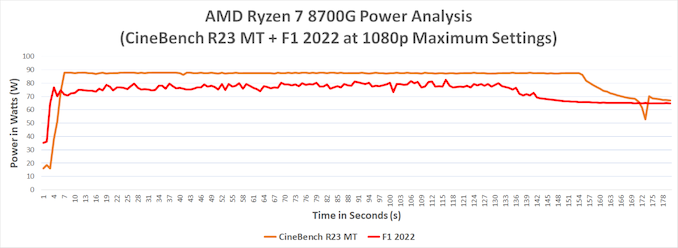
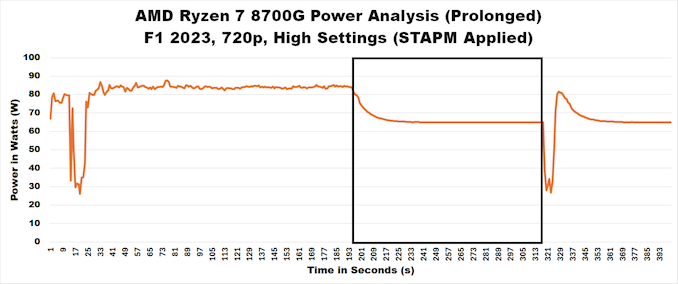
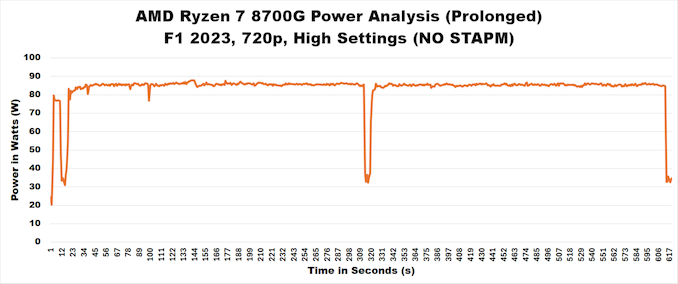








111 Comments
View All Comments
TheinsanegamerN - Wednesday, January 31, 2024 - link
If its being sold as a desktop chip it should be compared against the desktop chips it is competing against. If I am building a mini desktop with an APU the 7840u is irrelevant.meacupla - Wednesday, January 31, 2024 - link
Which, again, is hilarious.The facts point to 8700G and AM5 platform costing too much to make sense. If you want a cost effective gaming setup, you are better off with an i3 or R5 with dGPU.
8700G's one niche is ultra compact mITX without a dGPU. But if you go that route, it's now competing with.... oh look at that, the mini-PC segment.
maxijazz - Saturday, February 3, 2024 - link
Low power APUs as 7840, 8x00G are perfect for fanless (noiseless) mini desktops (audio servers) used in (so called) computer-audio industry, audio-hobby. Intel sucks in these applications recently.ermg_chips - Tuesday, January 30, 2024 - link
What I'm wondering is, are they going to come out with an 8700GE, 8600GE, etc eventually? The 5xxxGE series were the same CPUs but with a TDP set to 35W to fit in the same ultra-compact systems that the 35W intel -T chips do.I have a weird reason for caring, I live a nomadic/unstable lifestyle but still like to self-host all my shiz, so cramming as much compute into a "1 liter" PC as possible is important to me, and at my price point, I've been very happy with a 5750GE in a HP EliteDesk Mini stuffed with RAM as a teeny Proxmox box.
FWhitTrampoline - Monday, January 29, 2024 - link
It's just too bad that Intel did not release any 65W Meteor Lake S Socket Packaged variants As I would rather have built the Intel variant of the ASRock Desk Mini with Meteor Lake instead. And I have to LOL that the Tech Press can only Show the CPU only Blender 3D Cycles Rendering tests as there's no Radeon iGPU ROCm/HIP support for any Blender 3D iGPU accelerated Cycles Rendering testing.And Intel's Meteor Lake iGPUs have proper and working iGPU compute API support via Intel's OneAPI/Level-0 whereas on Linux AMD's ROCm/HIP GPU compute API support is just not there for Radeon iGPUs or for most Consumer Radeon dGPUs currently.
TheinsanegamerN - Tuesday, January 30, 2024 - link
It still wont fit in your in win chopin.FWhitTrampoline - Tuesday, January 30, 2024 - link
I do not own an Inwin Chopin but I do own an ASRock X300 Desk Mini and having to Blender Cycles render on the CPU cores and it's just too much for that OEM cooling solution to handle on the x300 sans any thermal throttling. But Because of the lack of Proper AMD ROCm/HIP support there for the Vega iGPU I can not make use of that for Blender 3D iGPU accelerated Cycles rending where there's plenty more FP units on the iGPU to accelerate the Ray Tracing calculations(Ray Tracing is a Compute Intensive workload).And I love how the Tech Press utilizes Blender 3D's CPU Cycles rendering as a CPU stress test and totally ignores any Blender 3D iGPU and dGPU Blender Cycles rendering tests to the point where that's basically ignored and an uncovered subject for the most part. But at least Intel cares more for creators there than AMD! Intel's got it's iGPUs support for Compute Workloads on Linux via OneAPI and Level-0 while AMD just lets the console makers to the hard part of tweaking AMD's APUs for Gaming Graphics workloads only!
But I'm going to have to wait for Arrow Lake to get any Socket Packaged Intel SKUs with the better Tile Based Graphics on a Desktop/Socket Packaged offering!
meacupla - Monday, January 29, 2024 - link
When you compare the 8700G results to 7840HS (Beelink GTR7), the performance difference is negligible.It seems to me that if you don't pair the 8700G with premium RAM, you would be further wasting your money.
t.s - Tuesday, January 30, 2024 - link
Seconded! With better power consumption too.AndrewJacksonZA - Monday, January 29, 2024 - link
Question: If a person has an APU, why use Blender CPU only?So on float8, there's a 2% difference between the 8700G and the i7-14900K. Wow.
Thank you